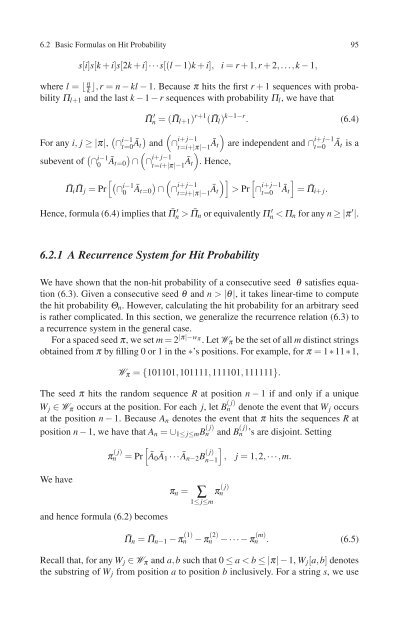Create successful ePaper yourself
Turn your PDF publications into a flip-book with our unique Google optimized e-Paper software.
6.2 Basic Formulas on Hit Probability 95<br />
s[i]s[k + i]s[2k + i]···s[(l − 1)k + i], i = r + 1,r + 2,...,k − 1,<br />
where l = ⌊ n k<br />
⌋,r = n − kl − 1. Because π hits the first r + 1 sequences with probability<br />
Π l+1 and the last k − 1 − r sequences with probability Π l , we have that<br />
For any i, j ≥|π|, ( ∩ i−1<br />
t=0Āt<br />
subevent of ( ∩ i−1 ) (<br />
0<br />
Ā t=0 ∩<br />
¯Π n ′ =(¯Π l+1 ) r+1 ( ¯Π l ) k−1−r . (6.4)<br />
)<br />
i+ j−1<br />
are independent and ∩t=0<br />
Ā t is a<br />
)<br />
∩ . Hence,<br />
)<br />
and<br />
i+ j−1<br />
(∩<br />
(∩ ) (<br />
i−1<br />
¯Π i ¯Π j = Pr[<br />
0<br />
Ā t=0 ∩ ∩<br />
t=i+|π|−1Āt<br />
i+ j−1<br />
t=i+|π|−1Āt<br />
i+ j−1<br />
t=i+|π|−1Āt<br />
)] [<br />
> Pr<br />
∩<br />
i+ j−1<br />
t=0<br />
Ā t<br />
]<br />
= ¯Π i+ j .<br />
Hence, formula (6.4) implies that ¯Π ′ n > ¯Π n or equivalently Π ′ n < Π n for any n ≥|π ′ |.<br />
6.2.1 A Recurrence System for Hit Probability<br />
We have shown that the non-hit probability of a consecutive seed θ satisfies equation<br />
(6.3). Given a consecutive seed θ and n > |θ|, it takes linear-time to compute<br />
the hit probability Θ n . However, calculating the hit probability for an arbitrary seed<br />
is rather complicated. In this section, we generalize the recurrence relation (6.3) to<br />
a recurrence system in the general case.<br />
For a spaced seed π,wesetm = 2 |π|−w π<br />
.LetW π be the set of all m distinct strings<br />
obtained from π by filling 0 or 1 in the ∗’s positions. For example, for π = 1∗11∗1,<br />
W π = {101101,101111,111101,111111}.<br />
The seed π hits the random sequence R at position n − 1 if and only if a unique<br />
W j ∈ W π occurs at the position. For each j, letB ( n<br />
j) denote the event that W j occurs<br />
at the position n − 1. Because A n denotes the event that π hits the sequences R at<br />
position n − 1, we have that A n = ∪ 1≤ j≤m B ( n j) and B ( n<br />
j) ’s are disjoint. Setting<br />
]<br />
π n<br />
( j) = Pr<br />
[Ā0 Ā 1 ···Ā n−2 B ( j)<br />
n−1<br />
, j = 1,2,···,m.<br />
We have<br />
and hence formula (6.2) becomes<br />
π n =<br />
∑<br />
1≤ j≤m<br />
π ( j)<br />
n<br />
¯Π n = ¯Π n−1 − π n (1) − π n<br />
(2) −···−π n (m) . (6.5)<br />
Recall that, for any W j ∈ W π and a,b such that 0 ≤ a < b ≤|π|−1, W j [a,b] denotes<br />
the substring of W j from position a to position b inclusively. For a string s, weuse

















